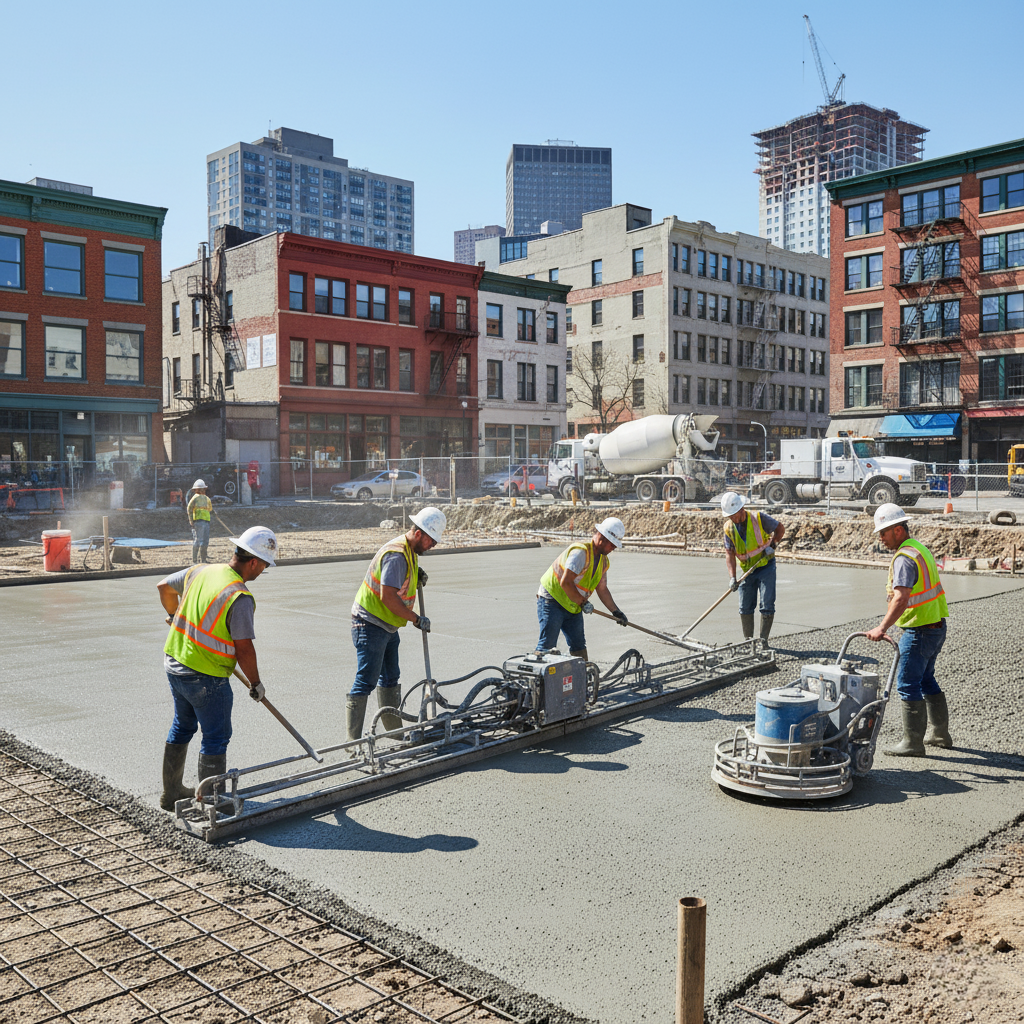
Best Practices for Commercial Concrete Flatwork in Union City, NJ
Commercial Concrete Union City
Commercial concrete flatwork in Union City requires adherence to stringent quality standards and local building codes to ensure long-lasting, functional surfaces for businesses throughout Hudson County. The city’s dense commercial environment and proximity to New York create unique demands for durable concrete installations that withstand heavy traffic, weather extremes, and intensive use. Professional contractors must navigate New Jersey’s Uniform Construction Code requirements while delivering cost-effective solutions that meet tight project schedules. Understanding these best practices helps property managers, developers, and business owners make informed decisions about their concrete flatwork investments. Proper execution of commercial concrete projects protects both immediate functionality and long-term property values in Union City’s competitive market.

Site Assessment and Preparation Standards
Comprehensive site assessment forms the foundation for successful commercial concrete flatwork projects in Union City. Professional evaluation begins with soil analysis to determine bearing capacity, drainage characteristics, and potential settlement issues common in Hudson County’s varied geological conditions. Properties near the Hudson River may encounter high water tables or soft soils requiring specialized preparation techniques.
Excavation standards for commercial projects typically require removal of 8-10 inches of existing material to accommodate proper base preparation and concrete thickness. The excavation must achieve a uniform grade and proper drainage slopes to prevent water accumulation under finished slabs. Professional contractors use laser-guided equipment to ensure precise grades that meet project specifications.
Subgrade preparation involves compacting the exposed soil to achieve specified density levels, typically 95% standard Proctor density for commercial applications. Unstable soils may require stabilization through chemical treatment, soil replacement, or geogrid reinforcement. Testing verification ensures the subgrade meets load-bearing requirements before proceeding with base installation.
Base course installation typically involves 4-6 inches of crushed stone aggregate compacted in lifts to achieve maximum density. The aggregate gradation must meet New Jersey DOT specifications for stability and drainage performance. Proper compaction eliminates voids that could cause future settling or cracking in the concrete slab.
Utility coordination prevents conflicts between concrete placement and existing infrastructure. Professional contractors verify utility locations through New Jersey 811 services and coordinate with facility managers to protect critical systems. Any utility modifications must be completed before concrete work begins to avoid schedule delays and additional costs.
Environmental and Regulatory Compliance
Union City’s environmental regulations require erosion control measures for commercial projects that disturb more than 5,000 square feet of surface area. Contractors must implement approved stormwater management plans that prevent sediment discharge during construction. Dust control measures protect neighboring businesses and comply with air quality standards.
Concrete Mix Design and Quality Control
Commercial concrete mix designs must meet specific performance criteria for strength, durability, and workability appropriate for intended use. Union City’s climate requires concrete mixes that resist freeze-thaw damage while providing adequate working time for placement and finishing. Professional contractors work with certified ready-mix suppliers to develop project-specific mix designs.
Compressive strength requirements typically range from 3,000 to 4,000 PSI for standard commercial flatwork, with higher strengths specified for heavy-duty applications like loading docks or equipment pads. The mix design must achieve the specified strength while maintaining workability for proper placement and finishing. Air entrainment of 4-7% helps resist freeze-thaw damage in Union City’s variable climate.
Quality control testing begins with mix design verification through laboratory testing before project commencement. Field testing during construction includes slump tests to verify consistency, air content measurements, and compressive strength specimens taken according to ASTM standards. Professional contractors maintain detailed testing records for quality assurance and warranty documentation.
Admixture selection enhances concrete performance for specific applications and environmental conditions. Water-reducing admixtures improve workability while maintaining strength, while accelerating admixtures help achieve strength goals in cool weather. Corrosion-inhibiting admixtures protect reinforcement in aggressive environments.
Ready-mix delivery coordination ensures continuous concrete placement without cold joints or delays that compromise quality. Contractors schedule deliveries to maintain adequate concrete supply while avoiding excessive wait times that affect workability. Communication between the job site and concrete supplier prevents placement problems and maintains project schedules.
Material Certifications and Documentation
Commercial projects require comprehensive material certifications demonstrating compliance with project specifications and industry standards. Contractors maintain certified mill test reports for all concrete ingredients, admixture documentation, and testing records throughout the project. This documentation supports warranty coverage and future maintenance planning.
Reinforcement and Structural Requirements
Commercial concrete flatwork typically requires reinforcement to handle anticipated loads and prevent cracking from thermal movement. Welded wire mesh or rebar grids provide tensile strength that concrete alone cannot achieve. The reinforcement design must consider load requirements, slab thickness, and joint spacing to optimize performance.
Rebar placement follows engineering specifications for size, spacing, and concrete cover requirements. Standard commercial slabs often use #4 or #5 rebar in 18-24 inch grids, positioned at mid-depth of the slab cross-section. Proper support systems maintain reinforcement position during concrete placement to ensure adequate cover and structural performance.
Welded wire mesh offers economic reinforcement for lighter-duty applications where rebar may be excessive. The mesh must be positioned properly within the slab cross-section and lapped according to specifications to provide continuous reinforcement. Chairs or other support systems prevent reinforcement from settling during concrete placement.
Fiber reinforcement provides additional crack control through synthetic or steel fibers distributed throughout the concrete mix. This reinforcement supplements traditional rebar or mesh while improving impact resistance and surface durability. Fiber dosage rates depend on application requirements and desired performance characteristics.
Load transfer devices at construction joints ensure structural continuity across slab segments. Dowel bars transfer loads between adjacent slabs while allowing horizontal movement from thermal expansion. Proper dowel installation requires precise alignment and adequate concrete cover to prevent corrosion and maintain structural performance.
Special Applications and Heavy-Duty Requirements
Loading docks, equipment pads, and high-traffic areas require enhanced reinforcement and thicker concrete sections to handle concentrated loads. These applications may require specialized mix designs with higher-strength concrete and additional reinforcement. Professional engineering ensures adequate design for specific load requirements and usage patterns.
Placement and Finishing Techniques
Professional concrete placement begins with proper formwork installation that maintains accurate elevations and smooth edges. Forms must be rigid enough to withstand concrete pressure without deflection while providing clean, straight lines. Release agents prevent concrete adhesion to forms and facilitate easy removal after curing.
Concrete placement proceeds systematically to avoid segregation and ensure uniform density throughout the slab. Contractors use mechanical screeds or laser-guided equipment to achieve specified elevations and surface smoothness. Proper consolidation through internal vibration eliminates voids and ensures full compaction around reinforcement.
Surface finishing creates the desired texture and appearance while achieving specified tolerances for flatness and levelness. Commercial applications typically require smooth, hard surfaces that resist wear and provide safe working conditions. Professional finishers use power trowels and specialized tools to achieve consistent surface quality.
Float finishing follows initial concrete placement to bring cream to the surface and prepare for final finishing operations. Power floats cover large areas efficiently while achieving a uniform surface texture. Multiple passes with progressively finer blades create increasingly smooth surfaces appropriate for commercial use.
Trowel finishing provides the final surface texture and achieves specified smoothness tolerances. Professional finishers coordinate timing with concrete setting characteristics to avoid surface defects like blisters or delamination. Multiple trowel passes create increasingly smooth surfaces suitable for specific commercial applications.
Joint installation controls cracking by providing predetermined failure locations where movement can occur without damaging the slab. Control joints are cut or formed at regular intervals based on slab thickness and aggregate characteristics. Isolation joints separate slabs from columns, walls, and other structural elements.
Surface Tolerances and Quality Standards
Commercial flatwork must meet specific tolerances for surface flatness and levelness depending on intended use. Warehouse floors require different tolerances than office spaces or retail areas. Professional contractors use precision instruments to verify compliance with project specifications and industry standards like ACI 117.
Curing and Protection Procedures
Proper curing ensures concrete achieves design strength and durability by maintaining adequate moisture and temperature during hydration. Commercial projects often require accelerated schedules that demand careful curing management to achieve early strength while ensuring long-term performance. Professional contractors implement proven curing methods appropriate for project conditions and requirements.
Wet curing involves keeping concrete surfaces continuously moist for specified periods, typically seven days minimum for standard applications. Methods include ponding, continuous spraying, or wet burlap covering, depending on surface configuration and accessibility. This method provides optimal strength development and surface quality.
Membrane curing uses liquid compounds that form a protective film, preventing moisture loss from concrete surfaces. This method offers convenience for large areas where wet curing may be impractical. The curing compound must be compatible with any planned surface treatments or coatings applied later.
Steam curing accelerates strength development for projects requiring rapid construction schedules. Controlled temperature and humidity create optimal conditions for cement hydration while reducing time to achieve specified strengths. This method requires specialized equipment and experienced personnel to prevent thermal shock damage.
Protection during curing prevents damage from construction traffic, weather exposure, and other potential hazards. Temporary coverings shield surfaces from rain, freezing temperatures, or excessive heat that could compromise concrete quality. Access restrictions prevent premature loading that could cause permanent damage.
Temperature monitoring ensures proper curing conditions throughout the critical strength development period. Professional contractors use data loggers to track temperature and adjust protection measures as needed. This documentation demonstrates proper curing procedures for quality assurance and warranty purposes.
Cold and Hot Weather Procedures
Union City’s variable climate requires seasonal modifications to curing procedures. Cold weather protection prevents freezing damage during early strength development, while hot weather measures prevent rapid moisture loss and thermal cracking. Professional contractors adjust procedures based on weather forecasts and actual conditions.
Quality Assurance and Testing Protocols
Comprehensive quality assurance programs ensure commercial concrete flatwork meets all performance requirements and specifications. Testing protocols verify concrete quality from initial mix design through final strength achievement. Professional contractors maintain detailed records demonstrating compliance with project requirements and industry standards.
Pre-construction testing validates mix designs and establishes baseline performance characteristics. Laboratory testing includes compressive strength development, durability characteristics, and workability parameters. This testing identifies potential issues before field placement and provides specification compliance documentation.
Field testing during construction monitors concrete quality and placement procedures. Standard tests include slump measurement for consistency, air content verification, and compressive strength specimens for strength development tracking. Testing frequency follows project specifications and industry standards for statistical validity.
Surface testing evaluates flatness, levelness, and other quality parameters after concrete placement. Professional contractors use precision instruments to verify compliance with specified tolerances. Non-destructive testing methods can evaluate concrete quality without damaging finished surfaces.
Documentation requirements include maintaining complete records of all testing activities, material certifications, and quality control measures. This documentation supports warranty claims, future maintenance planning, and regulatory compliance. Professional contractors provide complete packages upon project completion.
Third-party inspection services provide independent verification of quality control procedures and specification compliance. These services are often required for large commercial projects or when specified by building codes. Independent inspection adds credibility to quality documentation and may be required for warranty coverage.
Performance Monitoring and Maintenance Planning
Long-term performance monitoring helps identify maintenance needs before they become major problems. Professional contractors provide guidance on inspection schedules, maintenance procedures, and performance expectations. This proactive approach maximizes service life and protects property investments.
Specialized Applications and Advanced Techniques
Union City’s diverse commercial environment requires specialized concrete applications beyond standard flatwork. These applications demand advanced techniques and specialized expertise to achieve the required performance characteristics. Professional contractors must understand these requirements and implement appropriate solutions.
Industrial floors in warehouses and manufacturing facilities require enhanced durability and load-bearing capacity. These applications often specify high-strength concrete with specialized reinforcement and surface treatments. Proper joint design becomes critical for handling heavy equipment loads and preventing damage from material handling operations.
Retail and office applications prioritize appearance and comfort while maintaining durability. These surfaces may receive decorative treatments, polishing, or special coatings that require compatible concrete mixes and finishing techniques. Surface preparation becomes critical for the successful application of these treatments.
Food service and healthcare facilities require surfaces that meet strict sanitation and safety standards. Concrete mixes and finishing techniques must support required cleaning procedures while providing slip-resistant surfaces. Special sealers or coatings may be necessary to prevent contamination and facilitate maintenance.
Parking structures demand concrete that resists salt damage, freeze-thaw cycles, and heavy traffic loading. Enhanced reinforcement, specialized mix designs, and protective treatments help achieve the required service life in these demanding environments. Proper drainage design prevents water accumulation that accelerates deterioration.
Loading docks and truck courts handle extremely concentrated loads requiring thick sections and heavy reinforcement. These applications often require specialized aggregate and high-strength concrete to handle impact loading and abrasion. Joint design must accommodate heavy traffic while maintaining structural integrity.
Integration with Building Systems
Commercial concrete flatwork must integrate seamlessly with building mechanical systems, utilities, and architectural elements. Professional coordination ensures compatibility between concrete installation and other construction activities. This integration affects scheduling, sequencing, and technical requirements for successful project completion.
Project Management and Scheduling
Successful commercial concrete projects require careful planning and coordination with other construction activities. Professional project management ensures efficient resource utilization while maintaining quality standards and meeting schedule commitments. Effective communication between all project stakeholders prevents delays and costly mistakes.
Scheduling coordination aligns concrete work with other trades and building systems installation. Concrete placement must be timed to avoid conflicts with structural work, utility installation, and other critical path activities. Weather considerations affect scheduling decisions and may require contingency planning for seasonal variations.
Resource planning ensures adequate materials, equipment, and personnel are available when needed. Professional contractors maintain relationships with reliable suppliers and subcontractors who can meet project requirements. Backup plans address potential supply disruptions or equipment failures that could affect schedules.
Quality control checkpoints throughout the project verify compliance with specifications and identify potential issues early. Regular inspections and testing provide feedback on construction progress and quality achievement. Early identification of problems allows corrective action before they affect project completion.
Communication protocols keep all stakeholders informed of project progress, schedule changes, and quality issues. Regular project meetings provide forums for coordination and problem-solving. Clear documentation of decisions and changes prevents misunderstandings that could affect project success.
At Union City Concrete Works, we specialize in delivering superior commercial concrete flatwork that meets the demanding requirements of Union City’s business community. Our experienced team understands local codes, environmental conditions, and quality standards essential for successful commercial projects. We combine proven construction techniques with modern equipment and quality materials to deliver flatwork installations that provide decades of reliable service while enhancing property values throughout Hudson County.



